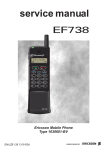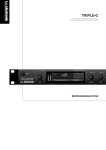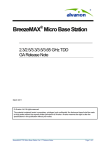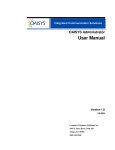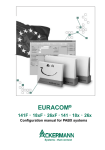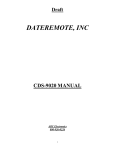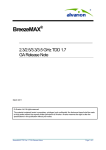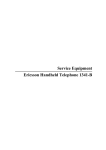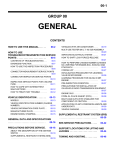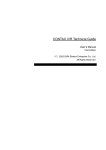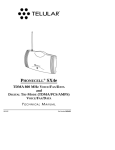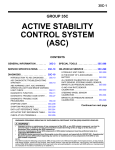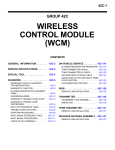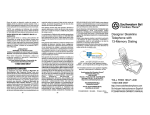Download Test/Service Programs Ericsson Mobile Phone EF738
Transcript
Test/Service Programs Ericsson Mobile Phone EF738 Test/Service Programs 2 Test/Service Programs Contents Test Equipment_____________________________________ 5 Recommended Instruments _________________________________ 5 Other Equipment__________________________________________ 6 Test Program_______________________________________ 7 How to Use _______________________________________________ 7 Initiating the Test Program ______________________________________ 7 Return to TEST INPUT ________________________________________ 7 Exit ________________________________________________________ 7 Individual Test Options ____________________________________ 8 Overview of the Test Program __________________________________ 15 ETACS Service Program ____________________________ 17 Hardware Requirements___________________________________ Software Installation ______________________________________ Starting the Program _____________________________________ The Programming Cycle___________________________________ Using the Menus _________________________________________ 17 18 18 19 19 How to Select _______________________________________________ The Functions _______________________________________________ File_____________________________________________________ Edit ____________________________________________________ Short Numbers____________________________________________ Options _________________________________________________ 19 20 20 21 31 31 Re-Programming a Telephone ______________________________ 32 Contents of Saved Short Number Files _______________________ 32 Keypad NAM Programming _________________________ 33 Long NAM Programming__________________________________ 34 Programmable Parameters _____________________________________ 34 Programming Instructions _____________________________________ 36 Default Values ______________________________________________ 38 Quick NAM Programming _________________________________ 40 Programmable Parameters _____________________________________ 40 Programming Instructions _____________________________________ 41 Default Values ______________________________________________ 42 Flash Programming ________________________________ 43 Introduction _____________________________________________ 43 Hardware Requirements___________________________________ 43 Software Setup ___________________________________________ 43 Installing the Shell Program ____________________________________ 44 Installing a Flasher Program____________________________________ 44 Flash Operation __________________________________________ 45 Hardware Setup _____________________________________________ 45 Flashing Instructions__________________________________________ 45 3 Test/Service Programs 4 Test/Service Programs Test Equipment The type of equipment required for service on the Ericsson Mobile Phone EF738 is listed below and includes instruments, tools, and other hardware. Descriptions of the programs for test, service, NAM programming, ESN transfer, and software upgrading are also included in the following subsections. Recommended Instruments Instrument Recommended Unit Alternative 1: Radio Test System Marconi 2960 lternative 2: Communication Test Set Schlumberger 4031 Alternative 3: Communications Test Set Schlumberger 4015 Alternative 4: Radio Test Set Signalling Unit Rohde & Schwarz CMS 52 Rohde & Schwarz CMS-B13 Other alternatives: Oscilloscope Multimeter Digital Voltmeter Power Supply Unit Tektronix 2235 Hewlett-Packard 3468A Fluke 8060A Power Box EK030-10 POWER SUPPLY GROUND CABLE (black) SUPPLY CABLE (red) GROUND SUPPLY ANTENNA CABLE ANTENNA ADAPTER INSTRUMENT (FRONT) RF IN/OUT IN-AUDIO-OUT C A R C R A D L E DB-9 IN - AF - OUT DB-15 D U M M Y B A T T E R Y LPC 102 280 KRY 101 1612/2 5 Test/Service Programs Other Equipment Equipment ETACS Service Program Programming Interface Connection Cable Adapter Car Cradle Test Handset Antenna Cable Antenna Cable Adapter Dummy Battery Service Adapter Kit - Test Interface Box - Audio Box - Power Supply 110V - Power Supply 220V Ordering Number NTZ 112 311 KRY 101 1135/10 LPC 102 280 KRY 109 1001/72 NTZ 112 210 NTZ 112 294 RNT 403 012/003 NTZ 112 310 LPC 102 280 KRY 101 1612/51 KRY 101 1612/54 KRY 101 1612/55 Standard tools and soldering equipment must also available Note: When servicing mobile telephones, it is most important that a bench earthing network is used to protect sensitive components against electrostatic discharge (ESD). 6 Test/Service Programs Test Program How to Use This document will describe the use of the built-in test program for the EF738. After the more extensive descriptions found in Individual Test Options, an overview follows in the form of a table with data referring to the different options. This table will become a handy alternative after having some experience of the test program. Initiating the Test Program The test program is initiated from the special test handset; by holding down the M button and pressing 90 40 59 or by pressing 90 40 59 followed by M M However, if the Test Program Enter function is enabled in the telephone, the program can be initiated and run directly from the keypad by pressing the same sequence (M = MENU). When the phone enters the test mode, the hardware becomes initialized and the text TEST INPUT appears in the display. To step forward and backwards in the test program; press SEND and RCL. To choose a specific test; press its number followed by the # button. Return to TEST INPUT Press the C or M button to return to the input mode where the TEST INPUT prompt is displayed. Exit To exit from the test program; select test option 99 and press the # button. 7 Test/Service Programs Individual Test Options A list describing the use of the test program options follows below. A summary of the test options and possible parameter values is given as well. 1 CH NUMBER Setting of channel number Choose any chanel in the ETACS system (0-600, 1329-2047). Default setting is channel 1. To change channel number; enter a 4-digit decimal number followed by #. Use * and # to step backwards/forwards. Channel number and signal strength are displayed. 8 2 TX POWER Sets the transmitter on and offF and determines the output power level. 8 off 7 power level 7; minimum output power 6 power level 6 5 power level 5 4 power level 4 3 power level 3 2 power level 2; maximum output power When the power reduction function is activated in menu 76, power level 2 will be displayed as ‘S’. When the extra power option in menu 76 is activated, power level 2 will be displayed as ‘X’. 4 FLASHER Used only when loading the program into a terminal. 5 PWR CAL Calibration of power levels. Transmitter is turned on and tuned to the calibration channel. Modify the power levels with the following keys: # / * increases/decreases the power level M+S stores the value and steps to next power level; transmitter is turned on M+# starts calibration and displays power level; steps forward to next power level (2->3->...->7->2). C turns off TX, restores channel no., returns to menu 0. 6 TX DETECT Performs two simple transmitter tests: a general Go/NoGo transmitter test and a transmitter leakage test. To start the test, press any key except C. The result is displayed when the test is finished: FF both tests passed 01 general transmitter test failed 02 leakage test failed 7 TX SENS Factory and level 5 repair only Test/Service Programs 9 RF CAL Calibrates the RSSI levels based on the level of the signal currently being received. The value determined for each level is the minimum strength signal for that level, averaged over 16 readings to provide a more reliable value. The value for level 0 is used to update the Receiver Carrier Detect (RXCD) such that signals below this level are ignored. This value (plus a fixed offset) also determines the minimum signal threshold for the AFC. When the received signal is below this threshold, the AFC provides TCXO compensation based on a default temperature compensation table. The values for level 1 and 5 are used to determine the RSSI graph to display. The values for level 2, 3 and 4 are interpolated from these two reference levels. M+# displays the next RSSI level number and its current value M+S reads an averaged RSSI value and stores it 10 RX SENS Adjustment of the receiver audio output M+# enables calibration and echoes the initial value # / * increases/decreases the value by 1; new value is echoed M+S stores the current value 11 KEYPAD Factory and level 5 repair only 13 BANDGAP Factory and level 5 repair only 14 AUDIO DEV Adjustment of the audio deviation M+# enables calibration and echoes the initial value # / * increases/decreases the value by 1; new value is echoed M+S stores the current value 15 AFC Sets the AFC operating mode and displays AFC information 0 only temperatue compensation 1 temp. + age compensation 2 temp. + age + freq. compensation, smoothed (default) 3 temp. + age + freq. compensation, no smooth 4 no compensation Any other code entered in handset mode will display: ABCCDDEEFF where A = AFC operating mode 0 only temperatue compensation 1 temp. + age compensation 2 temp. + age + freq. compensation, smoothed (default) 3 temp. + age + freq. compensation, no smooth 4 no compensation 9 Test/Service Programs B = AFC state 1 waiting for signal; (no valid RSSI, compensate for temp. or temp. + age) 2 acquiring lock; (RSSI good, use whole freq. error for 1.5 sec for fast lock) 3 locked (RSSI good, use smoothed freq. compensation) 4 freeze lock ( RSSI temporarily lost, compensate for temp + age + (frozen) freq. error for up to 30 sec.) 5 locked using short count; (RSSI good, use smoothed freqcompensation); only entered when current savings is active; short freq. measurements is used to find freq. error compensation 6 entered when DRX has started; compensate for temp. + age + (frozen) freq. error. CC total compensation DD temperature table component EE age component FF frequency error component 10 18 DAC2CAL Calibration of the VCTCXO. M+# enables calibration and echoes the initial value # / * increases/decreases the value by 1; new value is echoed M+S stores the current value During the calibration the AFC is in ‘Temperature only compensation mode’ (Tp-15:0) Upon exiting the calibration the AFC returns to its previously selected operating mode. 19 RX SAT Factory and level 5 repair only 20 AUDIO Sets the audio paths in the audio circuit Key TX-audio RX-audio 0 muted muted 1 unmuted muted 2 muted unmuted 3 unmuted unmuted 21 HANDSET Sets the audio paths in the handset. 0 microphone off, earphone off, loudspeaker off (default) 1 microphone on, earphone on, loudspeaker off 2 microphone off, earphone off, loudspeaker on 22 TX SAT Controls the SAT tone switch and TX SAT deviation. 0 generate 5970 Hz SAT 1 generate 6000 Hz SAT 2 generate 6030 Hz SAT 3 no SAT generated 4 SAT tone switch setting = ON 5 SAT tone switch setting = OFF M+# enables calibration and echoes the initial value # / * increases/decreases the value by 1; new value is echoed M+S stores the value Test/Service Programs 23 MANCH OUT Controls the wideband data and deviation To transmit these data the transmitter must be switched on. 0 off - no data output) 1 8kHz output; ones 2 8kHz output; zeros 3 hardcoded idle frame; 0101010101 M+# enables calibration and echoes the initial value # / * increases/decreases the value by 1; new value is echoed M+S stores the value 24 MANCH IN Displays the latest received data from the base station. The value is displayed each time a key is pressed. 25 VOLUME Sets the earpiece and loudspeaker volume. Possible values: 0 - 7 (default: 3) 26 DTMF DTMF tones consist of a lower frequency in combination with a higher frequency. The test enables listening to either or both as follows: 0 low frequency 1 high frequency 2 both frequencies. # / * scroll forwards/backwards to next/previous DTMF tone M+# enables calibration and echoes the initial value # / * increase/decrease the value by 1; new value is echoed M+S stores the value 27 TX SOURCE Sets the TX audio paths in the audio circuit. Also possible to adjust the levels of the different audio paths. 0 external line input, ATMS (default) 1 internal MIC 2 internal MIC with MicAmp gain M+# enables calibration and echoes the initial value # / * increases/decreases the value by 1; new value is echoed M+S stores the value 28 EARPIECE Sets the earpiece mute switch in the audio circuit to allow for adjustment of the earpiece sensitivity values. 0 1 2 internal earpiece disconnected internal earpiece connected audio sent out AFMS on system connector (default) internal earpiece and AFMS can both be adjusted M+# enables calibration and echoes the initial value # / * increases/decreases the value by 1; new value is echoed M+S stores the value 29 COMP Selects compander or linear mode M+# displays the current compander settings M+0 linear mode (default) M+1 companding mode 11 Test/Service Programs 30 HF Controls the handsfree attenuation level for RX and TX audio M+0 selects RX handsfree audio gain settings and echoes initial gain settings M+1 selects TX handsfree audio gain settings and echoes initial gain settings 0-7 sets the gain for the selected path: 0=0dB, 1=-7dB, 2= -14dB, ... 7=-49dB 32 SOFTLIMIT Sets the use of the softlimiter in the audio circuit. Changes made are temporary and will not update the EEPROM. 12 35 COUNTRY Factory and level 5 repair only 36 BER Factory and level 5 repair only 37 OMC Factory and level 5 repair only 38 ADC Displays the different hex values from the ADC M+1 RSSI M+2 battery voltage M+3 unused M+4 temperature sense M+5 bandgap reference M+6 current sense M+7 handsfree level 39 DAC Changes temporarily the output voltage from the DAC. M+1 normally controlled by AFC M+2 normally trimmed using ‘MENU 18’ M+3 power level xxx M+# decimal value followed by ‘MENU + #’ sent directly to the active DAC (valid values: 000 - 255) #/* increases/decreases value by 1; new value is echoed 40 INPORT Shows the status of the different inports (updated every second) M+1 external audio connection detected 0 = input high 1 = input low M+2 state of CPU port 2 M+3 flip status 0 = flip closed 1 = flip open M+4 transmitter status 0 = transmitter off 1 = transmitter on M+6 external handsfree detected 0 = input low 1 = input high M+7 receiver carrier detect 0 = RSSI < sensitivity limit 1 = RSSI > sensitivity limit # immediately reads the selected port Test/Service Programs 41 OUTPORTS Shows the status of the selected outport First select a digital outport: M+1+0 VRX M+1+1 VTX, Note! VRX must be on! M+1+2 power down VCO M+1+3 unused M+1+4 SWDC M+1+5 MPD2 M+1+6 FMPD1 M+1+7 unused M+1+8 temperature M+2 ICTRL M+3 MUTE M+4 green LED M+5 red LED M+6 back light Then select the state: 0 set output low 1 set output high 42 DSCR Turns the discriminator and multiplier on and off 0 discriminator off 1 discriminator on (default) 43 BAR Tests the different tones of the phone 0 continous ringing signal at maximum volume 1 continuos alarm signal 2 click signal single pulse 3 error signal single pulse 4 continuous 3kHz ringing tone 45 LCD Tests the different segment and icons of the display as five different patterns M+digit (1-5)shows the selected pattern no. (1-5) # shows all patterns continuously starting with pattern no. 1 C or S terminates the test 46 PWR DOWN Factory and level 5 repair only 47 SW REV Displays the software, revision and ESN inside the terminal. Press any key to show software name and revision. Additional pressure of any key will show the ESN. 48 SYNTH Factory and level 5 repair only 49 RX PWR MODE Factory and level 5 repair only 50 GUARANTEE Press any key to display year and month when warranty/guarantee was activated and the length (months)of the warranty period 53 SYNT I SET Factory and level 5 repair only 54 EEPROM INIT Factory and level 5 repair only 13 Test/Service Programs 60 SYNTH Factory and level 5 repair only 61 AUDIO CIRCUIT Factory and level 5 repair only 62 RADIO CTRL Factory and level 5 repair only 74 TCA TEST Checks the ETACS combining algorithm 76 BATT SAVE Controls the reduced and extra power functions 0 off 1 power reduction invoice channel (power level 2 only) 2 extra power (power level 2 only) 77 EEDATA Factory and level 5 repair only 79 PIN Factory and level 5 repair only 91 EEPROM DUMP Factory and level 5 repair only 92 EEPROM LOAD Factory and level 5 repair only 96 COLD START Clears the RAM, exits service & test mode, and powers up in ‘terminal charge only mode’ # exit service & test mode; power up in normal mode M+# exit service & test mode; power up in charge only mode 14 97 FLASH CHSUM Calculates the checksum of the flash memory # 2 bytes checksum will be displayed 98 ERROR Factory and level 5 repair only 99 EXIT Press # to exit the service program Test/Service Programs Overview of the Test Program Menu Possible Values 1 CH NUMBER 0-600, 1329-2047 2 TX POWER 8 (off) - 2 (maximum power) 4 FLASHER only used when loading program into terminal 5 PWR CAL calibration of power levels 6 TX DETECT simple test of transmitter 7 TX SENS factory and level 5 repair only 9 RF CAL RSSI calibration 10 RX SENSE adjustment of receiver audio output 11 KEYPAD factory and level 5 repair only 13 BANDGAP factory and level 5 repair only 14 AUDIO DEV adjustment of maximum audio deviation 15 AFC sets AFC operating mode and displays AFC information 18 DAC2CAL calibration of VCTCXO 19 RX SAT factory and level 5 repair only 20 AUDIO sets audio paths in audio circuits 21 HANDSET sets audio paths in handset 22 TX SAT controls SAT tone switch and TX SAT deviation 23 MANCH OUT controls wideband data and deviation 24 MANCH IN displays latest received data from base station 25 VOLUME sets earpiece and loudspeaker volume 26 DTMF DTMF tones 27 TX SOURCE sets TX audio paths in audio circuit 28 EARPIECE sets earpiece mute switch in audio circuit 29 COMPAND selects compander/linear mode 30 HF controls handsfree attenuation level for RX and TX audio 32 SOFTLIMIT sets use of softlimiter in audio circuit 35 COUNTRY factory and level 5 repair only 36 BER factory and level 5 repair only 37 OMC factory and level 5 repair only 38 ADC displays different hex values from ADC 39 DAC changes temporarily output voltage from DAC 40 INPORTS shows status of different inports 15 Test/Service Programs 16 Menu Possible Values 41 OUTPORTS selects status of selected outport 42 DISCR turns discriminator/multiplier on/off 43 BAR tests different tones of phone 45 LCD tests different segments and icons of display 46 PWR DOWN factory and level 5 repair only 47 SW REV displays software, revision and ESN inside terminal 48 SYNTH factory and level 5 repair only 49 RX PWR MODE factory and level 5 repair only 50 GUARANTEE warranty information 53 SYNT I SET factory and level 5 repair only 54 EEPROM INIT factory and level 5 repair only 60 SYNTH factory and level 5 repair only 61 AUDIO CIRCUIT factory and level 5 repair only 62 RADIO CTRL factory and level 5 repair only 74 TCA TEST checks ETACS combining algorithm 76 BATT SAVE controls reduced and extra power functions 77 EEDATA factory and level 5 repair only 79 PIN factory and level 5 repair only 91 EEPROM DUMP factory and level 5 repair only 92 EEPROM LOAD factory and level 5 repair only 96 COLD START powers up in ‘terminal charge only mode’ 97 FLASH CHSUM calculates checksum of flash memory 98 ERROR factory and level 5 repair only 99 EXIT press # to exit service program Test/Service Programs ETACS Service Program The ETACS Service Program is a tool used for entering the initializing customer parameters into the EEPROM of the Ericsson mobile phone EF738. This description of the ETACS Service Program includes information on: • hardware requirements • software setup • programming instructions Hardware Requirements The following equipment is required when using the ETACS Service program for the EF738 Ericsson mobile phone: • • • • • PC with Windows 3.1 or Windows 95 operating system COM port (COM1 - COM2) available on the PC Programming cable, KRY 101 1135/10 R1A Programming interface, NTZ 112 311 Adapter, 25- to 9-pin; for PC equipped with a 9-pin COM-connector ( not supplied by Ericsson) . Fully charged battery NTZ 112 311 3 4 1 2 KRY 101 1135/10 R1A 17 Test/Service Programs Software Installation The ETACS Service Program consists of four files: • • • • SPEP1361.EXE TYPE1361.CFG TYPE1361.EDT TYPE1361.MNU The program can be run directly from a diskette, but it is adviseable to have it run from the hard disk. Simply install the software on the hard disk by copying the contents of the diskette to a suitable directory on the hard disk. The copying of files mentioned above describes how to install the ETACS Service Program from a standard floppy disk, but the program may become distributed in other media formats. CAUTION! Use a fully charged phone battery, since the interface is powered by the phone. Using an even slightly discharged battery may result in misreadings, even if the Low Battery warning has not yet appeared. Starting the Program Turn the phone On. Start the program by double-clicking the file SPEP1361.EXE in the File Manager / Explorer, and the following picture appears on the screen: File Edit Short Numbers Options SELECT COM PORT 1 Press digit 1 to use COM1: 2 Press digit 2 to use COM2: Esc Press ESC to continue. Select the serial port (COM1 or COM2) where the programming interface is connected, as instructed on the screen. 18 Test/Service Programs The Programming Cycle Details of the different entries are given in ‘Using the Menus’. Below is a brief description of the main events. After selection of the COM port the Subscriber Data editing window is automatically displayed. Most customers will require data to be entered in this window only. Move the cursor by the arrow keys of the PC, or click the mouse on the respective field of the window. Press the Esc key to return to the main menu on the top row of the screen. SUBSCRIBER DATA Subscriber No. part1 0836 Subscriber No. part2 123456 Mobile Stat. Id. No. 123456 ACCOLC 5 Home Traffic AID 0803 Guarantee Start,mmyy 1097 Guarantee Length,mm 12 Lock Code 0000 The service program will fetch ‘today’s date’ from the system clock of the PC. Check and (if necessary) correct the date before starting the programming. When ready to program the telephone, i.e. transfer data into the EEPROM: • Press F2 while keeping the ALT-key depressed (ALT+F2) • Confirm by pressing the Y-key After the programming the result can be verified by pressing ALT+F3. To exit the program, press ALT+X. Using the Menus How to Select Press Esc to reach the menu. From a 'Data edit window' it is also possible to go directly to a sub-menu by holding down the ALT key and pressing the highlighted letter in the main menu, e.g. ALT+F to go to File functions. Move the selection bar (reverse video) to the left or right by the keypad arrow keys to select a sub-menu and press Enter to open it. The functions in the sub-menu are selected by moving the selection bar up or down using the arrow keys. Press Enter to activate the selected function, or Esc to return to the main menu. Sub-menus and functions can also be reached by clicking with the mouse. 19 Test/Service Programs The Functions NOTE! Defaults are printed in italic. File The ‘File’ sub-menu includes the functions listed below: File Read Burn Verify Save Load Reset PIN Activate DRX Deactiv. DRX EXit Alt Alt Alt Alt Alt Alt Alt Alt Alt F1 F2 F3 F5 F6 F7 F8 F9 X Read Transfers the contents of the EEPROM to the computer memory. CAUTION! When using this function, make sure to reload the configuration file before programming other phones, as incorrect data inadvertently might be programmed. Burn Programs the phone with the Subscriber, Country and System data that has been entered into the PC memory. Verify Comparison between the PC memory and the phone. Save This command has two different functions: 1. Creates a configuration file which is automatically loaded at each program start. The file name must be manually changed to TYPE1361.CNF. All data from the edit windows are saved. Guarantee Start is set to ‘today's date’ by the system clock. 2. Saves the data in the phone before service. Data in the edit windows is saved if the file name is other than TYPE1361.CNF. Default name is STATION1.SAV. Load Reloads a configuration file. Reset PIN Resets the PIN to 0000. Activate DRX Activates the Discontinuous Reception feature. CAUTION! May deteriorate the performance of the phone, if DRX is not supported by the system Deactivate DRX Deactivates the Discontinuous Reception feature. Exit 20 Quit the program. Test/Service Programs Edit When leaving the ‘File’ menu the ‘Subscriber Data’ edit window is displayed. After pressing Esc the ‘Edit’ sub-menu is reached and the editing windows listed below can be accessed: Edit Subscriber Data Misc MMI Features Sounds & General Call Set & CallData System & Services Sys Opt & Restrict. Languages NAM & Quick NAM Country data 1 Country data 2 Country data 3 Country data 4 SUBSCRIBER DATA SUBSCRIBER DATA Subscriber No. part1 0836 Subscriber No. part2 123456 Mobile Stat. Id. No. 123456 ACCOLC 5 Home Traffic AID 0803 Guarantee Start,mmyy 1097 Guarantee Length,mm 12 Lock Code 0000 Subscriber No. Part 1/Part 2 The Subscriber No. (shown in certain menues and at power on) is information intended for the user and is not used by the system. Mobile Station Identification No. The 6 least significant digits of the international mobile station number, usually identical to the 6 least significant digits of the subscriber number. ACCOLC The Access Overload Class is normally the second last digit of the Mobile Station Identification No. Home Traffic AID The Home Traffic Area Identification is entered as a hexadecimal code. Guarantee Start, mmyy Is read from the PC's system clock at program start, but can be manually altered. Guarantee Length, mm To be used in conjunction with the Guarantee Start. Lock Code The subscriber's four-digit lock code which must initially be set to 0000 to comply with the information of the User's Manual. 21 Test/Service Programs MISCELLANEOUS MMI FEATURES MISC MMI FEATURES Roam. indicat. type Auto Retry Call Count Feature Arrow Indication Left Arrow Segments Right Arrow Segments Int. lock digits Three level menu N Y Y 1 22C0 0251 0A Y Roaming Indicator Type Y = Icon flashing N = Icon steady on Auto Retry Y = Enables Automatic Retry when network is busy N = Disables Automatic Retry when network is busy Call Count Feature Y = Enables registration of unanswered incoming calls N = Disables registration of unanswered incoming calls Arrow Indication 0: no arrow is displayed 1: one arrow is displayed 2: one arrow followed by hyphen is displayed Left Arrow Segments Layout of Left Arrow Segments: 22C0HEX, (not to be changed) Right Arrow Segments Layout of Right Arrow Segments: 0251HEX, (not to be changed) International Lock Digits No. of digits as hex. code to define the minimum length of an international phone number Three Level Menu Y = 3-level user menu structure is set to comply with the User’s Manual N = 2-level user menu structure 22 Test/Service Programs SOUNDS & GENERAL SOUNDS & GENERAL Ring Vol Menu Y Ringtone Menu Y Keysound Menu Y Silent Menu Y Not used, set to N N N N Backlite Menu Y Greeting Menu Y Language Menu Y Reset Menu Y Mem Used Menu Y Keylock Menu Y Not used, set to N N N Ring Volume Menu Y = Ringing volume selection ‘Low/Med/High/Step/Silent’ enabled N = Ringing volume selection disabled. RingTone Menu Y = Ringing tone selection ‘Low/Med/High/Mixed/Scale/Fast/Melodies’ enabled N = Ringing tone selection disabled. KeySound Menu Y = Key sound selection ‘Burst/Continuous/Click/Silent’ enabled N = Key sound selection disabled Silent Menu Y = Silent Mode selection ‘Off/On’ enabled N = Silent Mode selection disabled BackLite Menu Y = Backlight selection ‘Off/On 10sec/On 20sec’ enabled N = Backlight selection disabled Greeting Menu Y = Greeting String (at power on) choice enabled N = Greeting String disabled Language Menu Y = Language selection ‘English/Espanol/Italiano/Deutsch/Melayu’ enabled N = Language selection disabled Reset Menu Y = Reset option ‘Reset All’ enabled N = Reset option disabled Memory Used Menu Y = Memory Used Menu is accessable N = Memory Used Menu not accessible KeyLock Menu Y = Key lock selection ‘Unlock/Lock’ enabled N = Key lock selection disabled 23 Test/Service Programs CALL SET & CALL DATA CALL SET & CALLDATA Fastdial Menu Y Flip Menu Y Answ Opt Menu Y Minder Menu Y Tonesend Menu Y Acc Tone Menu Y N Air Info Menu Call Type Menu Y LastTime Menu Y LastChar Menu N Tot Time Menu Y Tot Char Menu N Call Cnt Menu Y Not used, set to N N N N FastDial Menu Y = Fast Dial (one-key-dial) selection ‘Off/On’ enabled N = Fast Dial selection disabled Flip Menu Y = Flip (answer/end-call) selection ‘Off/On’ enabled N = Flip answer/end-call disabled Answering Option Menu Y = Answering method selection ‘Any Key/Send Only’ enabled N = Answering method selection disabled Minder Menu Y = Minder (minute beep) selection ‘Off/On’ enabled N = Minder selection disabled Tone Send Menu Y = Tone Send (DTMF when key pressed during call) selection ‘Off/On’ enabled N = Tone Send selection disabled Access Tone Menu Y = Access Tone (outgoing call established) selection ‘Off/On’ enabled N = Access Tone selection disabled Air Info Menu Y= Air Info (duration or charge) display selection ‘Air Time/Call Charge’ enabled N = Air Info disabled Call Type Menu Y = Call Type charge (out or out/in) display selection ‘Only Out/Out and In’enabled N = Call Type charge display selection disabled Last Time Menu Y = Last Time (duration of last call) display selection enabled N = Last Time display selection disabled Last Charge Menu Y = Last Charge (no. of charge units for last call) display selection enabled N = Last Charge display selection disabled Total Time Menu Y = Total Time (since counter reset) display selection enabled N = Total Time display selection disabled 24 Test/Service Programs Total Charge Menu Y = Total Charge (since counter reset) display selection enabled N = Total Charge display selection disabled Call Count Menu Y = Call Count (no. of in/out-going calls since reset) display selection enabled N = Call Count display selection disabled 25 Test/Service Programs SYSTEM & SERVICES SYSTEM & SERVICES ETACS Type ITACS Type MS supp. TACS level Call Line Identific. Long NAM Prog. Entry Test Program Entry Country Menu Entry Rescan Time, minutes Handset Feature No of Auto Retries Sys. Busy Wait Time Called side BW Time Keypad Layout Type ABC Indicator Debug Not used, set to 00 Y N 1 Y N N Y 5 N 3 0A 1E 1 0 00 ETACS Type Y = Phone is an ETACS type N = Phone is a TACS only type ITACS Type Y = Phone is an ITACS type N = Used in combination with ETACS type Mobile Station supported TACS level 0: if TACS 1: if TACS-2 Calling Line Identification Y = Calling Line Identification functions enabled N = Calling Line Identification functions disabled Long NAM Programming Entry Y = User access to the NAM menu is enabled N = User access to the NAM menu is disabled Test Program Entry Y = The test program is accessed by entering a code on the keypad N = The test program cannot be accessed from the keypad Country Menu Entry Y = User access to the Country Menu is enabled N = User access to the Country Menu is disabled Rescan Time, minutes No. of minutes until a Rescan is started (default: 5 minutes) after signalling Handset Feature Y = Handset Feature enabled N = Handset Feature disabled No. of Auto Retries Max. number of Automatic Retries (default: 3) System Busy Wait Time Time between attempts in Auto Retry when system is busy (default: 0AHEX) Called Side Busy Wait Time Time between attempts in Auto Retry when called number is busy (default: 1EHEX) 26 Test/Service Programs Keypad Layout Type 0: Not applicable 1: New international alpha keypad layout ABC Indicator Debug Enables the use of special indicators, ‘ABC’, for internal tests: 0: not used 1: NAM system indication 2: Accessory indication 3: Data/Voice mode 4: TX power indication 5: Power save indication 27 Test/Service Programs SYSTEM OPTIMIZATION & RESTRICTIONS SYS OPT & RESTRICT. Enable NAM Selection Y Enable Country Sel. Y Not used, set to N N N N N N N Sec Code Menu Y Not used, set to N N N N N N N N Mem Only Menu Y Y No Calling Menu No Inter Menu Y Auto Lock Menu Y Not used, set to N N N N N Enable NAM Selection Y = NAM selection enabled N = NAM selection disabled Enable Country Selection Y = Country selection enabled N = Country selection disabled Security Code Menu Y = Security Code (4-digit personal code) Menu is accessible N = Security Code Menu not accessible Memory Only Menu Y = Memory Only (calls from mem. pos. 1-10 only) Menu is accessible N = Memory Only Menu not accessible No Calling Menu Y = No Calling (receive only) Menu is accessible N = No Calling Menu not accessible No Inter Menu Y = No Inter (no international calls) Menu is accessible N = No Inter Menu not accessible Auto Lock Menu Y = Auto Lock (phone locked at power-up) Menu is accessible N = Auto Lock Menu not accessible 28 Test/Service Programs LANGUAGES LANGUAGES Not used, set to Y Spanish Italian Deutsch Melayu Not used, set to N Y Y Y Y Y N N N Spanish Y = Spanish language selectable N = Spanish language not selectable Italian Y = Italian language selectable N = Italian language not selectable Deutsch Y = German language selectable N = German language not selectable Melayu Y = Malayan language selectable N = Malayan language not selectable NAM & QUICK NAM NAM & QUICK NAM ESN Y CODE Y ROAM TYPE Y CHARGE Y CHAN, FCCHA, FCCHB Y Y Y BANDA, BANDB Y Y NO EMERG Y EMERG 1, EM.2, EM.3 Y Y Y ENQUIRY Y INTER PREF Y NAM Y IMSI, SUBN Y Y SYSTEM Y AIDH, FPCH, ROAM Y Y Y ACCOLC, LOCAL, EXT Y Y Y Not used, set to Y/N Y Y Y Y Y Y Y Y N N Y N N N N N Y N Y N Y N N N N N N N Y N N N N N N N N N N The table above displays the various programmable parameters for: • NAM programming (center column) • Quick NAM programming (right column) By entering a Y, the parameter becomes accessible for programming. By entering a N, the parameter becomes not accessible for programming. The default settings for the accessibility of the NAM and Quick NAM parameters are as listed in the table above. For more detailed information, refer to ‘Keypad NAM Programming’ which is found further on in this section. 29 Test/Service Programs COUNTRY DATA The example below shows one out of four country dependent data tables. The parameters are identical for all countries, but the settings will vary. COUNTRY DATA 1 Country Name UK CC Data, System A B 0023 21 0323 21 Station Class Mark 13 Enquiry Number 3 192 No of Emergency No.s 2 Emergency no. 1 3 999 Emergency no. 2 3 112 Emergency no. 3 0 Intern. Prefix Info 2 00 NAM User Selectable Y N Subscriber No. 0836123456 0836123456 Mobile Stat. Id. No. 123456 123456 ACCOLC, AID 5 0803 5 0803 Inter System Roaming N N System A A First Paging Channel 0023 0023 Country & Netw. Code 234 A 234 A Send Ext. MS Number N N Resp. to Local Mess. N N Country Name If the Country Name contains less than ten letters, remaining positions can be blank. CC Data, System A B First control channels and the number of control channels for system A and B. Values are to be entered in decimal form. Station Class Mark The Station Class Mark is always set tot 13HEX. Enquiry Number The number of digits of the Enquiry Number and the actual Enquiry Number. No. of Emergency Numbers The total number of available Emergency Numbers. Emergency No. 1 The number of digits of the Emergency Number and the actual Emergency Number. Emergency No. 2 As Emergency No.1, if available, otherwise set to 0. Emergency No. 3 As Emergency No.1, if available, otherwise set to 0. International Prefix Information The number of digits of the International Prefix and the actual International Prefix. NAM User Selectable Y = NAM can be selected by the user N = NAM cannot be selected Note! First NAM must always be enabled Subscriber No. The Subscriber Number is a max. 10-digit number from which the user may want only part of it to be displayed. Enter A for 10-digit display, or enter 0 to 9 for the reduced number of digits, counted from the end digit. The Subscriber No. is information aimed for the user and is not used by the system. 30 Test/Service Programs Mobile Station Identification No. The 6 least significant digits of the international mobile station number, in most countries equal to the 6 least significant digits of the subscriber number. ACCOLC, AID The Access Overload Class, normally the last digit of the Mobile Station Id. No., followed by the Home Traffic Area Identification entered as hex. code. Inter System Roaming Y = Inter System Roaming enabled N = Inter System Roaming disabled System A = System A is the home system in the NAM B = System B is the home system in the NAM First Paging Channel First paging channel in the present NAM to be entered in decimal form. Country & Network Code Mobile Country Code (3 digits), followed by Mobile Network Code (1 digit), for the present NAM. Send External Mobile Station Number Y = Phone must send the extended address word when accessing the system N = Extended address word not required when accessing the system Response to Local Message Y = Phone must respond to local control messages sent on the FOCC N = Response not required to local control messages sent on the FOCC Short Numbers Short Numbers Save To Disk Load From Disk Clear Mobile Save To Disk Reads the short numbers from the telephone and transfers them to a file, see below. Load From Disk Reads short numbers from a file and stores (burns) them in the phone. Clear Mobile Clear all short numbers in the phone. Options Options Com Port COM Port Possible to change the COM-port whithout leaving the program, for example, when having programming interfaces connected to both COM-ports. 31 Test/Service Programs Re-Programming a Telephone When making changes to a telephone that has already been programmed, first read the EEPROM by pressing ALT+F1. Then perform the desired changes and program the EEPROM by pressing ALT+F2. Verify by pressing ALT+F3. Note: Make sure that the configuration file has been reloaded before programming other phones. Otherwise incorrect data may inadvertently be programmed. Contents of Saved Short Number Files The ‘Save’ file is a normal text file which may be edited by any word processor or text editor as an ASCII text file. It is possible to create a file independently from the program, and then use the program for transfer to the telephone. The file does not have to list the short numbers in any particular order, and it is not necessary to supply all 99 numbers. For example, it is possible to create a file with only three short numbers at pos. 21, 22, and 23, and add these to a phone that already has some numbers programmed. Each line of the file should have the following form: 1. Two digits representing the Short Number positions from 01 through 99. 2. Name of the subscriber, maximum 10 characters, letters and digits. 3. Telephone number of no more than 16 or 32 characters (system dependent). Digits 0 - 9, * , and # are allowed. Example: 01 ERICSSON 0094646193000 02 JOHN DOE 12345678 03 TRANSFER *21*9171234567# Lines containing the positions only will erase the shortcodes, for example: 04 05 06 A line containing text only ‘NO NUMBERS’ is a comment and will not cause any programming of the telephone. 32 Test/Service Programs Keypad NAM Programming The Keypad NAM (Number Assignment Modules) Programming includes not only the NAM parameters but also some functionally related parameters as well as country dependent parameters. Two different Keypad NAM Programming modes are available: • Long NAM (non-user selectable by default) • Quick NAM (always selectable) A list of the available programmable parameters, programming instructions, and country-related default values for Long resp. Quick NAM follows. 33 Test/Service Programs Long NAM Programming Programmable Parameters Electrical Serial Number (ESN) The ESN, which is a unique binary number that identifies the MS to the cellular system, is set by the factory and can not be modified. Security Code This code gives the user access to protected memory locations, resetting of menus, and setting of call restrictions. Roam Type The roaming indicator can be set in three different modes: off, flashing, steady-on. Subscription with Charge Rate This parameter determines whether AirTime/CallCharge is selectable by the user. Number of Channels Defines the allowed number of channels according to the frequency band. First Dedicated Control Channel in System A This control channel number can be programmed in service mode for internal tests. First Dedicated Control Channel in System B This control channel number can be programmed in service mode for internal tests. Total Number of Dedicated Control Channels in System A Maximum number of dedicated control channels in System A. Total Number of Dedicated Control Channels in System B Maximum number of dedicated control channels in System B. Number of Emergency Numbers Determines the number (≤3) of available emergency numbers for the country. Emergency Number 1 States the first emergency number. Emergency Number 2 States the second emergency number (if exists). Emergency Number 3 States the third emergency number (if exists). Enquiry Number States the enquiry number Country International Prefix Prefix required when dialing an international call. This parameter detects an international call at call restrictions. 34 Test/Service Programs NAM Each country area is subdivided into NAM-areas NAM1 and NAM2, which are programmed with System A and System B parameters when shipped from factory. A configuration of system and subscriber data (preferred system, subscriber number, etc.) can be programmed into each NAM. International Mobile Station Identity (IMSI) This IMSI identity is a 10-digit number composed of three parts: - MNC (Mobile Network Code), 3 digits - MCC (Mobile Country Code), 1 digit - MSIN (Mobile Station Identification Number), 6 digits Subscriber Number The subscriber number may include from 0 up to 10 digits. Pref Sys Both NAMs associated with each country are programmable to become operable in both systems. If both systems are programmed as System A, the automatic NAM switch function will search the A system channels for both NAMs. Home System Identity Number (AID) This identity number states the subscriber home system and is provided by the subscription operator. First Paging Channel The first paging channel is programmed in service mode and the appropriate value for this parameter is provided by the home system operator at subscription. Roam This parameter defines whether inter system roaming is allowed on the complementing network or not. If set, it will enable the use of both systems (A and B) in the present NAM. Access Overload Class Overload class field that controls access attempts made by the MS (identical to the second last digit of the IMSI). Response to Local Control Message Enabled Determines whether the MS will respond to Local Control Messages sent on the Forward Control Channel. Sending of Extended MS Number Determines whether the MS must send the extended address word when accessing the system. 35 Test/Service Programs Programming Instructions To enter the Long NAM Programming mode: - press 9 2 3 8 8 5, MENU, MENU or - keep the MENU key depressed while pressing 9 2 3 8 8 5 After entering the Long NAM Programming mode, the phone exits the Standby mode, turns off the radio, and becomes non-operational. Key Functions 36 Key Function MENU Saves value and steps forward ↑ Saves value and steps forward ↓ Saves value and steps backwards MEM Moves to beginning of present menu * Moves to beginning of NAM submenu (when in NAM menu) # Moves to beginning of Long NAM Programming menu CLR Returns to previous value 0-9 Entry of numbers and toggling of values End/Pwr/No Exit from Long NAM Programming mode Test/Service Programs NOTE! Due to the limited amount of display characters, some parameters will be displayed as two parts, an intro text shown for 1 second followed by the numeric data (indicated as two text rows in the Display-column below). Menu Type Display Menu Action ESN (Electrical Serial No.) ESN 123 12345678 1 3 most significant digits shown 1 sec; Remaining digits shown thereafter Security code CODE 2 Code shown (set in menu mode) Roam type ROAMTYPE 0 4 Press ‘0-9’ to switch ‘ROAMTYPE1’ Subscription with charge rate CHARGE OFF 5 Press ‘0-9’ to switch ‘CHARGE ON’ Number of channels CHAN 1320 6 Press ‘0-9’ to switch ‘CHAN 600’ 1st dedicated control channel in System A FCCHA 0 0 2 3 7 Enter number (0000-0600,1329-2047) incl. leading zeroes 1st dedicated control channel in System B FCCHB 0323 8 Enter number (0000-0600,1329-2047) incl. leading zeroes Total no. of dedicated control channels in System A BANDA 0 0 2 1 9 Enter 4-digit number incl. leading zeroes Total no. of dedicated control channels in System B BANDB 0 0 2 1 10 Enter 4-digit number incl. leading zeroes No. of emergency numbers NO EMERG 1 11 Enter digit 0-3 Emergency number 1 EMERGENCY1 911 12 Enter max. 10 digits, press ‘MENU’ or ‘↑’ to go to next emerg. no, if any Enquiry number ENQUIRY 13 Enter a number with max. 10 digits 0000 912 Country international prefix INTER PREF 07 14 Enter a number with max. 4 digits NAM NAM 1 15 Press ‘0-9’ to switch ‘NAM2’ International Mobile Station Identity Number (IMSI) IMSI 1 1111110111 16 Enter a 10-digit number Subscriber number SUBNUMBER1 1111110111 17 Enter a max. 10-digit number Pref Sys SYSTEM1 A 18 Press ‘0-9’ to switch ‘SYSTEM1 B’ Home system identity number (AID) AID1 00000 19 Enter a number (00000-32767) incl. leading zeroes 1st paging channel FPCH1 0023 20 Enter a number (000-600,1329-2047) incl. leading zeroes Roam ROAM1 ON 21 Press ‘0-9’ to switch ‘ROAM1 OFF’ Access overload class ACCOLC1 01 22 Enter two digits (00-15). Default = 0 + second last IMSI digit Response to local control message enabled LOCAL 1 ON 23 Press ‘0-9’ to switch ‘LOCAL1 OFF’ Sending of extended MS number EXT1 ON 24 Press ‘0-9’ to switch ‘EXT1 OFF’ 37 Test/Service Programs Default Values Parameter Austria China Hong Kong Ireland Italy Malaysia Security code 0000 0000 0000 0000 0000 0000 Roam type 0 0 0 0 0 0 Subscription with charge rate off off off off off off Number of channels 1320 1320 1320 1320 1320 1320 1st dedicated control channel in System A 0023 0023 1996 0023 0023 0023 1st dedicated control channel in System B 0323 0323 0323 0323 0323 0323 Total no. of dedicated control channels in System A 0021 0021 0021 0021 0021 0021 Total no. of dedicated control channels in System B 0021 0021 0021 0021 0021 0021 No. of emergency numbers 3 2 3 2 3 2 Emergency number 1 122 110 112 999 116 999 Emergency number 2 133 119 110 112 113 112 Emergency number 3 144 119 Enquiry number 11611 108 192 Country international prefix 00 00 00 00 00 00 International Mobile Station Identity Number (IMSI) 232 0 123456 460 0 123456 454 2 123456 234 0 123456 222 2 123456 502 0 123456 Subscriber number 0000 123456 0836 123456 90 123456 0836 123456 0337 123456 0000 123456 Pref Sys A A A A A A Home system identity number (AID) 26625 02051 11083 02051 24641 18435 1st paging channel 0023 0023 1996 0023 0023 0023 Roam off off off off off off Access overload class 05 05 05 05 05 05 Response to local control message enabled off off off off off off Sending of extended MS number off off off off off off ESN (Electrical Serial No.) 112 103 NAM 38 Test/Service Programs Parameter Philippines Singapore Spain UK Kuwait Security code 0000 0000 0000 0000 0000 Roam type 0 0 0 0 0 Subscription with charge rate off off off off off Number of channels 1320 1320 1320 1320 1320 1st dedicated control channel in System A 0023 0023 0023 0023 0023 1st dedicated control channel in System B 0323 0323 0323 0323 0323 Total no. of dedicated control channels in System A 0021 0021 0021 0021 0021 Total no. of dedicated control channels in System B 0021 0021 0021 0021 0021 No. of emergency numbers 2 2 0 2 2 Emergency number 1 110 995 999 999 Emergency number 2 119 112 112 112 ESN (Electrical Serial No.) Emergency number 3 Enquiry number 5319828 908 192 192 00 00 07 00 00 International Mobile Station Identity Number (IMSI) 460 0 123456 525 7 123456 214 8 123456 234 0 123456 234 0 123456 Subscriber number 0836 123456 7 123456 908 123456 0836 123456 0836 123456 Pref Sys A B B A A Home system identity number (AID) 02051 20480 23552 02051 02051 1st paging channel 0023 0323 0323 0023 0023 Roam off off off off off Access overload class 05 05 05 05 05 Response to local control message enabled off off off off off Sending of extended MS number off off off off off Country international prefix NAM 39 Test/Service Programs Quick NAM Programming The number of programmable parameters available in Quick NAM Programming is defined, as earlier described, in ETACS Service Program (NAM & Quick NAM). The parameters below are the available Quick NAM Programmable Parameters as set by default. Programmable Parameters Electrical Serial Number (ESN) The ESN, which is a unique binary number that identifies the MS to the cellular system, is set by the factory and can not be modified. Subscription with Charge Rate This parameter determines whether AirTime/CallCharge is selectable by the user. Country International Prefix Prefix required when dialing an international call. This parameter detects an international call at call restrictions. International Mobile Station Identity (IMSI) This IMSI identity is a 10-digit number composed of three parts: - MNC (Mobile Network Code), 3 digits - MCC (Mobile Country Code), 1 digit - MSIN (Mobile Station Identification Number), 6 digits Subscriber Number The subscriber number may include from 0 up to 10 digits. Home System Identity Number (AID) This identity number states the subscriber home system and is provided by the subscription operator. 40 Test/Service Programs Programming Instructions To enter the Quick NAM Programming mode: - press 9 8 7, MENU, MENU or - keep the MENU key depressed while pressing 9 8 7 By scrolling forward ‘↑’ or backwards ‘↓’, all NAMs will be reached. NOTE! Due to the limited amount of display characters, some parameters will be displayed as two parts, an intro text shown for 1 second followed by the numeric data (indicated as two text lines in the Display-column below). Menu Type Display Menu Action ESN (Electrical Serial No.) ESN 123 12345678 1 3 most significant digits shown 1 sec; Remaining digits shown thereafter Subscription with charge rate CHARGE OFF 2 Press ‘0-9’ to switch ‘CHARGE ON’ Country international prefix INTER PREF 07 3 Enter a number with max. 4 digits International Mobile Station Identity Number (IMSI) IMSI 1 1111110111 4 Enter a 10-digit number Subscriber number SUBNUMBER1 1111110111 5 Enter a max. 10-digit number Home system identity number (AID) AID1 6 Enter a number (00000-32767) incl. leading zeroes 00000 41 Test/Service Programs Default Values Parameter Austria China Hong Kong Ireland Italy Malaysia Subscription with charge rate off off off off off off Country international prefix 00 00 00 00 00 00 International Mobile Station Identity Number (IMSI) 232 0 123456 460 0 123456 454 2 123456 234 0 123456 222 2 123456 502 0 123456 Subscriber number 0000 123456 0836 123456 90 123456 0836 123456 0337 123456 0000 123456 Home system identity number (AID) 26625 02051 11083 02051 24641 18435 Parameter Philippines Singapore Spain UK Kuwait Subscription with charge rate off off off off off Country international prefix 00 00 07 00 00 International Mobile Station Identity Number (IMSI) 460 0 123456 525 7 123456 214 8 123456 234 0 123456 234 0 123456 Subscriber number 0836 123456 7 123456 908 123456 0836 123456 0836 123456 Home system identity number (AID) 02051 20480 23552 02051 02051 ESN (Electrical Serial No.) ESN (Electrical Serial No.) 42 Test/Service Programs Flash Programming Introduction The Ericsson Mobile Maintenance Applications (EMMA) flash program is a tool used for upgrading and recovery of the software for the new generation of Ericsson mobile phones. This description of the EMMA flash program includes information on: • • • • hardware requirements software setup hardware setup flashing instructions Hardware Requirements The following equipment is required when using the EMMA flash program for the Ericsson mobile phones: • • • • • PC with Windows 3.1 (or later) operating system COM port (COM1 - COM4) available on the PC Programming cable, KRY 101 1135/10 R1A Programming interface, NTZ 112 311 Adaptor, 25- to 9-pin; for PC equipped with a 9-pin COM-connector ( not supplied by Ericsson) Software Setup The EMMA program consists of two separate programs, • the SHELL, one program common for all phone models based on this platform • the FLASHER, one program for each phone model which are installed in the above sequence. Note! The installation procedure below describes how to install the EMMA flash program by using standard floppy disks, but the program may become distributed in other media formats. 43 Test/Service Programs Installing the Shell Program It is not possible to install a Flasher program unless the Shell program first has been installed on the local hard disk or a network server. To install the Shell program, proceed as follows: 4. Close all active windows and insert the Shell disk. 5. In the Program Manager window, click on File and Run, type a:setup in the Command Line box, and click OK. 6. After a while, some important information is displayed. Read the information and click Next >. 7. The shell program suggests a Destination Location in the directory C:\emma\ If convenient, click Next >. If not convenient, click Browse, select a suitable directory, and click Next >. 8. The copying of files is begun and also displayed by several graphs. 9. After completion of the file copying, the installation of the Shell program is ended, but additional information can be retrieved by clicking Yes to the question Do you want to view the README file now? 10.Confirm the completion by clicking OK in the Information window and remove the disk. Note! The path and name of the Shell location directory must not be altered after completed installation. Installing a Flasher Program After having the Shell program installed, the Flasher programs of various phones based on the same platform are easily added: 1. Close all active windows and insert a Flasher disk. 2. In the Program Manager window, click on File and Run, type a:setup in the Command Line box, and click OK. 3. After a while, some important information is displayed. Read the information and click Next >. 4. The Flasher program suggests a path and subdirectory where the flasher program is placed. If convenient, click Next >. If not, click Browse, select a directory path that corresponds with the Shell location register, and click Next >. 5. The copying of files is begun and also displayed by several graphs. 6. After completion of the file copying, the installation of the Flasher program is ended. Confirm the completion by clicking OK in the Information window and remove the disk. 7. In the Program Manager a new window, EMMA, has been created, from which the Flasher program now can be opened and started by clicking on the group icon ETACS Flash. 44 Test/Service Programs Flash Operation Hardware Setup To make the setup for the upgrading of the mobile phones, follow the instructions below and refer to Figure 1. 1. Connect the programming interface NTZ 112 311 to an available COM port. 2. Connect the programming cable KRY 101 1135/10 R1A to the interface. 3. Connect a fully charged battery to the phone. 4. Connect the programming cable to the phone. Keep the phone turned OFF until further notice. Fully charged battery NTZ 112 311 3 4 1 2 KRY 101 1135/10 R1A Note! Use a fully charged phone battery, since the interface is powered by the phone. The use of an even slightly discharged battery may result in erroneous flashing. Flashing Instructions 1. In the EMMA window of the Program Manager, first double-click the subdirectory etacsflash and then double-click the wanted flasher program. 2. If the default Com Port has not previously been set: Click Settings and Com Port, select the default Com Port (Com1 - Com4), and click OK. 3. To check that the appropriate input file will be used: Click Settings and Input File, click Default to select the default file, or New to select a different input file. 45 Test/Service Programs 4. Check that the phone is connected to the PC with a fully charged battery as described on previous page. 5. Click Start to enter the flashing dialogue. If required, a Com Port different to the default port can be temporarily selected. The baud rate, 9600, is controlled by the program and can not be manu-ally altered. 6. Press the On/Off-key on the phone and click immediately Start to start flashing. Transfering hex load file is displayed. The flash memory is erased after which the actual flash programming process is begun and also displayed by a graph. 7. After completion, click OK to confirm SUCCESSFUL FLASHING!, disconnect the phone and, if required, connect an identical phone, and repeat the procedure as from step 5. 8. Exit the EMMA flash program. Note! If the flash programming is not succesful or has become interrupted during the flashing process, the flash connector and phone battery have to be disconnected and reconnected before the flashing can be resumed. 46














































